The tonsils revisited: review of the anatomical localization and histological characteristics of the tonsils of domestic and laboratory animals
- PMID: 21869895
- PMCID: PMC3159307
- DOI: 10.1155/2011/472460
The tonsils revisited: review of the anatomical localization and histological characteristics of the tonsils of domestic and laboratory animals
Abstract
This paper gives an overview of the anatomical localization and histological characteristics of the tonsils that are present in ten conventional domestic animal species, including the sheep, goat, ox, pig, horse, dog, cat, rabbit, rat, and pigeon. Anatomical macrographs and histological images of the tonsils are shown. Six tonsils can be present in domestic animals, that is, the lingual, palatine, paraepiglottic, pharyngeal, and tubal tonsils and the tonsil of the soft palate. Only in the sheep and goat, all six tonsils are present. Proper tonsils are absent in the rat, and pigeon. In the rabbit, only the palatine tonsils can be noticed, whereas the pig does not present palatine tonsils. The paraepiglottic tonsils lack in the ox, horse, and dog. In addition, the dog and cat are devoid of the tubal tonsil and the tonsil of the soft palate.
Figures
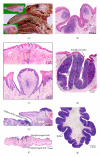
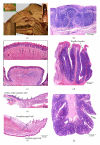
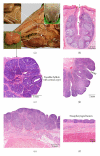
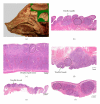
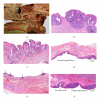

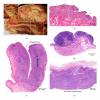

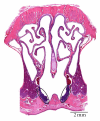

Similar articles
-
Histological characteristics and stereological volume assessment of the ovine tonsils.Vet Immunol Immunopathol. 2007 Dec 15;120(3-4):124-35. doi: 10.1016/j.vetimm.2007.07.010. Epub 2007 Jul 25. Vet Immunol Immunopathol. 2007. PMID: 17727965
-
Anatomical localisation and histology of the ovine tonsils.Vet Immunol Immunopathol. 2005 Aug 15;107(1-2):79-86. doi: 10.1016/j.vetimm.2005.03.012. Vet Immunol Immunopathol. 2005. PMID: 15885802
-
Main anatomical and histological features of the tonsils in the camel (Camelus dromedarius).Trop Anim Health Prod. 2016 Dec;48(8):1653-1659. doi: 10.1007/s11250-016-1139-x. Epub 2016 Sep 17. Trop Anim Health Prod. 2016. PMID: 27639878
-
Morphology and immunology of the human palatine tonsil.Anat Embryol (Berl). 2001 Nov;204(5):367-73. doi: 10.1007/s004290100210. Anat Embryol (Berl). 2001. PMID: 11789984 Review.
-
The palatine tonsil as an evolutionary novelty.Acta Otolaryngol Suppl. 1996;523:8-11. Acta Otolaryngol Suppl. 1996. PMID: 9082817 Review.
Cited by
-
Actinomyces denticolens colonisation identified in equine tonsillar crypts.Vet Rec Open. 2016 Sep 8;3(1):e000161. doi: 10.1136/vetreco-2015-000161. eCollection 2016. Vet Rec Open. 2016. PMID: 27651913 Free PMC article.
-
Effects of intranasal administration with Bacillus subtilis on immune cells in the nasal mucosa and tonsils of piglets.Exp Ther Med. 2018 Jun;15(6):5189-5198. doi: 10.3892/etm.2018.6093. Epub 2018 Apr 24. Exp Ther Med. 2018. PMID: 29805543 Free PMC article.
-
Histological and anatomical structure of the nasal cavity of Bama minipigs.PLoS One. 2017 Mar 24;12(3):e0173902. doi: 10.1371/journal.pone.0173902. eCollection 2017. PLoS One. 2017. PMID: 28339502 Free PMC article.
-
Attachment of Actinobacillus suis H91-0380 and Its Isogenic Adhesin Mutants to Extracellular Matrix Components of the Tonsils of the Soft Palate of Swine.Infect Immun. 2016 Sep 19;84(10):2944-52. doi: 10.1128/IAI.00456-16. Print 2016 Oct. Infect Immun. 2016. PMID: 27481253 Free PMC article.
-
Development and characterization of an immortalized nasopharyngeal epithelial cell line to explore airway physiology and pathology in yak (Bos grunniens).Front Vet Sci. 2024 Jul 17;11:1432536. doi: 10.3389/fvets.2024.1432536. eCollection 2024. Front Vet Sci. 2024. PMID: 39086762 Free PMC article.
References
-
- Kuper CF, Koornstra PJ, Hameleers DMH, et al. The role of nasopharyngeal lymphoid tissue. Immunology Today. 1992;13(6):219–224. - PubMed
-
- Strid J, Hourihane J, Kimber I, Callard R, Strobel S. Disruption of the stratum corneum allows potent epicutaneous immunization with protein antigens resulting in a dominant systemic Th2 response. European Journal of Immunology. 2004;34(8):2100–2109. - PubMed
-
- Liebler-Tenorio EM, Pabst R. MALT structure and function in farm animals. Veterinary Research. 2006;37(3):257–280. - PubMed
-
- Casteleyn C. Morphological characteristics of the ovine tonsils—a study of their volume and surface area, lymphoid tissue organization, lining epithelia and vascular architecture. Faculty of Veterinary Medicine, Ghent University; 2010. p. p. 9. Ph.D. thesis.
-
- Vaerman JP, Férin J. Local immunological response in the vagina, cervix and endometrium. Acta Endocrinologica. 1975;78(194):281–305. - PubMed
Publication types
MeSH terms
LinkOut - more resources
Full Text Sources
Miscellaneous

